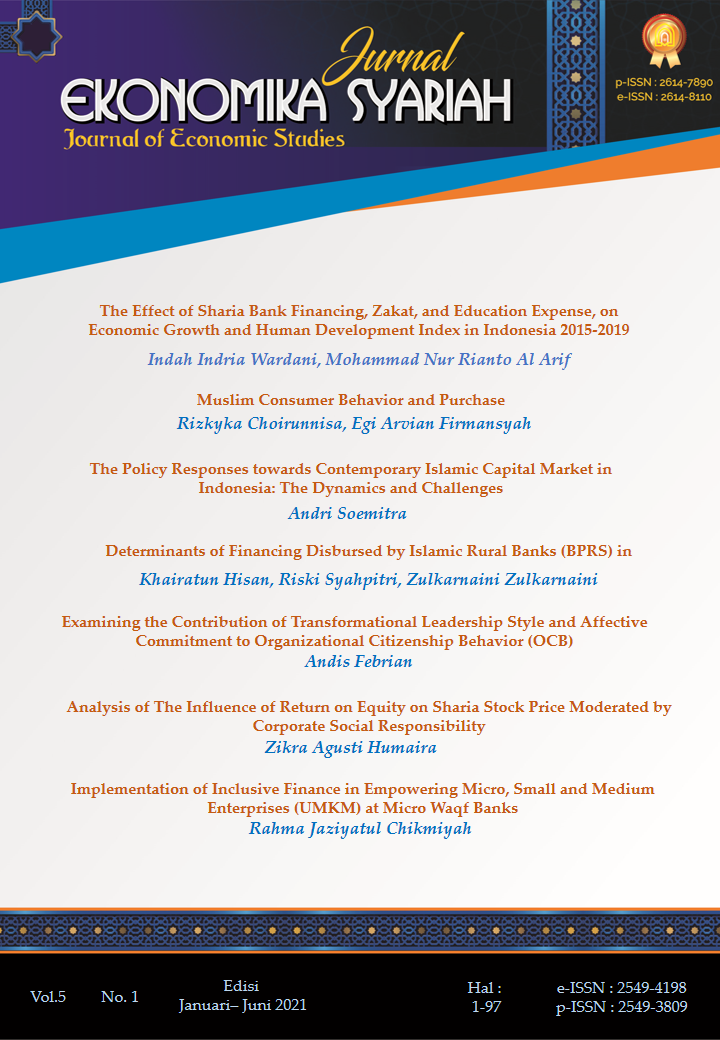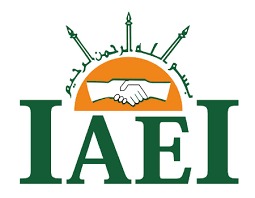Muslim Consumer Behavior and Purchase
DOI:
https://doi.org/10.30983/es.v5i1.4170Keywords:
Consumer Behavior, Purchasing Decision, Halal Cosmetics, PLS-SEMAbstract
This study aims to analyze the factors that influence the behavior of Muslim consumers in West Java in purchasing decisions of halal cosmetic products, which include factors of attitude, subjective norms, perceived behavioral control, religiosity, knowledge, and halal labeling. This study used descriptive and verification methods with a quantitative approach. The sample used in this study were 412 Muslim women with an age range of 15-64 years which were taken by purposive sampling technique. Data were collected through questionnaires and analyzed using the Partial Least Square-Structural Equation Model (PLS-SEM) method. The results of this research showed that attitude, subjective norm, religiosity, knowledge, and halal labeling have positive and significant impacts on purchasing decisions, while the perceptions of behavior control have no significant impacts on purchasing decisions. This finding showed that the purchase decision of halal cosmetic products of Muslim consumers can be influenced by several factors, and halal labeling has a greater influence. This study also reveals that some Muslim consumers do not know the halal label of a product. This research contributes to encouraging cosmetic companies that do not yet have halal certification to apply for halal certification and this finding is also a reference for the government to require halal certificates for cosmetic products.
Â
Penelitian ini bertujuan untuk mengetahui faktor-faktor yang mempengaruhi perilaku konsumen Muslim Jawa Barat dalam keputusan pembelian produk kosmetik halal, yang meliputi factor sikap, norma subjektif, persepsi kontrol perilaku, religiusitas, pengetahuan, dan labelisasi halal. Penelitian ini menggunakan metode deskriptif dan verifikatif yang dianalisis dengan pendekatan kuantitatif. Sampel yang digunakan dalam penelitian ini adalah sebanyak 412 perempuan Muslim berusia 15-64 tahun dan berdomisili di Jawa Barat yang diambil dengan teknik purposive sampling. Data dikumpulkan melalui kuesioner dan dianalisis dengan menggunakan metode Partial Least Square-Structural Equation Model (PLS-SEM). Hasil penelitian menunjukkan bahwa faktor-faktor seperti sikap, norma subjektif, religiusitas, pengetahuan, dan labelisasi halal memiliki pengaruh yang positif dan signifikan terhadap keputusan pembelian, sedangkan persepsi kontrol perilaku tidak memiliki pengaruh yang signifikan terhadap keputusan pembelian. Temuan ini menunjukkan bahwa keputusan pembelian produk kosmetik halal dari konsumen muslim dapat dipengaruhi oleh beberapa faktor, dimana labelisasi halal memiliki pengaruh yang lebih besar. Penelitian ini juga mengungkap bahwa sebagian konsumen muslim di Jawa Barat belum mengetahui label halal dari suatu produk. Penelitian ini berkontribusi dalam mendorong perusahaan kosmetik yang belum memiliki sertifikasi halal untuk mengajukan sertifikasi halal dan sebagai pertimbangan bagi pemerintah untuk mewajibkan produk yang beredar di Indonesia bersertifikat halal.
Â
References
Abd Aziz, Noreen Noor & Wahab, E., Understanding of Halal Cosmetics Products: TPB Model, UTHM Institutional Repository, 2013, h.1-6.
Ahmad, A. N., Rahman, A. A., & Rahman, S. A., Assessing Knowledge and Religiosity on Consumer Behavior towards Halal Food and Cosmetic Products, International Journal of Social Science and Humanity, Vol. 5, Issue 1, 2015, h.10-14.
Ajzen, I., The Theory of Planned Behavior, Organizational Behavior and Human Decision Processes, Vol. 50, Issue 2, 1991, h.179-211.
Ansari, N. U., & Mohammed, H., Factors Affecting the Intent to Purchase Halal Personal Care Products: Emirical Evidence from Pakistan, International Journal of Islamic Marketing and Branding, Vol. 1, issue 2, 2015, h.199.
Aspan, H., Sipayung, I. M., Muharrami, A. P., & Ritonga, H. M., The Effect of Halal Label, Halal Awarness, Product Price, and Brand Image to the Purchasing Decision on Cosmetic products (Case Study on Consumer of Sari Ayu Martha Tilaar in Binjai City), International Journal of Global Sustainability, Vol. 1, Issue 1, 2017, h.55.
Endah, N. H., Perilaku Pembelian Kosmetik Berlabel Halal oleh Konsumen Indonesia, Jurnal Ekonomi dan Pembangunan, Vol. 22, Issue 1, 2014, h.11-25.
Gefen, D., & Straub, D., A Practical Guide to Factorial Validity Using PLS-Graph: Tutorial and Annotated Example, Communications of the Association for Information System, Vol. 16, issue 7, 2005.
Hair, J. F., Marko, S., Lucas, H., & Volker, G. K., Partial Least Squares Structural Equation Modeling (PLS-SEM): An emerging tool in business research, Europian Business Review, Vol. 26, Issue 2, 2014, h.106-121.
Hawkins, D. I., Best, R. J., & Coney, K. A., (1992), Consumer Behavior: Implications for Marketing Strategy, Inc. Homewood, II.
Hussein, A. S., Penelitian Bisnis dan Manajemen Partial Least Squares dengan SmartPLS 3.0., Universitas Brawijaya, Vol. 1, 2015, h.1-19.
Juliandi, A., (2018) Structural Equation Model Partial Least Square (SEM-PLS), h.1-6.
Kadengkang, J. A., & Linarti, U., Pengukuran Perilaku dan Niat Beli Produk Kosmetik Halal melalui Modifikasi Theory of Planned Behavior (TPB), Jurnal Ilmiah Psikologi Terapan, Vol. 8, Issue. 1, 2020, h.25.
Kementerian Kesehatan, Rekapitulasi Industri Kosmetika Indonesia, http://apiffarmalkes.kemkes.go.id/grafik-kosmetik.php, diakses tanggal 12 Januari 2021.
Kementerian Perencanaan Pembangunan Nasional, (2018), Masterplan Ekonom Syariah Indonesia 2019-2024.
Kementerian Perindustrian Republik Indonesia, Kemenperin: Industri Kosmetik Nasional Tumbuh 20%, https://kemenperin.go.id/artikel/18957/IndustriKosmetik-Nasional-Tumbuh-2018, diakses tanggal 21 oktober 2020.
Lada, S., Tanakinjal, G. H., & Amin, H., Predicting intention to choose halal products using theory of reasoned action, International Journal of Islamic and Middle Eastern Finance and Management, 2009.
Larasati, A., Hati, S. R. H., & Safira, A., Religiusitas dan Pengetahuan Terhadap Sikap dan Intensi Konsumen Muslim untuk Membeli Produk Kosmetik Halal, Esensi: Jurnal Bisnis dan Manajemen, Vol. 8, Issue 2, 2018, h.105-114.
LPPOM MUI, Mengenal Bahan Kosmetika dan Obat-Obatan, http://www.halalmui.org/mui14/main/detail/mengenal-bahan-kosmetika-dan-obat-obatan, diakses tanggal 09 November 2020.
LPPOM MUI, Manajemen Rantai Pasok Halal dari Perspektif Sains, https://www.halalmui.org/mui14/main/detail/manajemen-rantai-pasok-halal-dari-perspektif-sains, diakses tanggal 03 Desember 2020.
LPPOM MUI, Kosmetik Halal, Cara Optimal untuk Cantik Luar Dalam, https://www.halalmui.org/mui14/main/detail/kosmetik-halal-cara-optimaluntuk-cantik-luar-dalam, diakses tanggal 03 November 2020.
MUI, (2009), Keputusan Fatwa Komisi Fatwa Majelis Ulama Indonesia Tentang Penetapan Produk Halal.
Mustar, Peta Sebaran Data Populasi Muslim Dunia 2020: Indonesia Paling Besar, https://www.gomuslim.co.id/read/news/2020/04/08/18593/-p-peta-sebarandata-populasi-muslim-dunia-2020-indonesia-paling-besar-p-.html, diakses tanggal 20 Oktober 2020.
Oktaniar, F., Listyaningsih, E., & Purwanto, B., The Effect of Halal Labeling, Advertisement Creativity and Lifestyle on Purchase Decisions of Wardah Products (Case Study of Students of Universitas Malahayati), KnE Social Sciences, 2020, h.692-700.
Paul Peter, J., & Olson, J. C., (2005), Consumer Behavior and Marketing Strategy, New York: McGraw-Hill International.
Sadzalia, S., (2015), Pengaruh label halal dan religiusitas terhaadap keputusan pembelian produk kosmetik di Kota Malang, Universitas Islam Negeri Maulana Malik Ibrahim Malang.
Sarstedt, M., Ringle, C. M., & Hair, J. F., (2017), Partial Least Square Structural Equation Modeling, Handbook of Market Research, Issue 9.
Simamora, B., (2002), Panduan riset perilaku kosumen, Gramedia Pusaka Utama.
Standard, D, (2019), State of the Global Islamic Economy Report 2019/20, Dubai International Financial Centre, h.1-174.
Taylor, S., & Todd, P., Decomposition and crossover effect in the theory of planned behavior: A study of consumer adoption intentions, International Journal of Research in Marketing, Vol. 12, issue 2, 1995, h.137155.
Wahyuningrum, A., Anasom, H., & Kusmanto, T. Y., Strategi Dakwah MUI (Majeis Ulama Indonesia) Jawa Tengah Melalui Sertifikasi Halal, Jurnal Ilmu Dakwah, Vol. 35, Issue 2, 2017, h.186.
Wahyuningsih, I., Intensi Konsumen Terhadap Kosmetik dan Produk Skincare Halal di Indonesia: Pendekatan Theory of Planned Behavior, JEBA (Journal of Economics and Busiess Aseanomics), Vol.3, Issue 1, 2019.
Wong, K. K.-K, Partial Least Squares Structural Equation Modeling (PLS-SEM) Techniques using SmartPLS, Marketing Bulletin, Vol. 24, Issue 1, 2013, h.1-32.
Downloads
Submitted
Accepted
Published
Issue
Section
License
Authors who publish with this journal agree to the following terms:
- Authors retain copyright and grant the journal right of first publication with the work simultaneously licensed under a Creative Commons Attribution-ShareAlike 4.0 International License that allows others to share the work with an acknowledgment of the work's authorship and initial publication in this journal.
- Authors are able to enter into separate, additional contractual arrangements for the non-exclusive distribution of the journal's published version of the work (e.g., post it to an institutional repository or publish it in a book), with an acknowledgment of its initial publication in this journal.
- Authors are permitted and encouraged to post their work online (e.g., in institutional repositories or on their website) prior to and during the submission process, as it can lead to productive exchanges, as well as earlier and greater citation of published work (See The Effect of Open Access).













